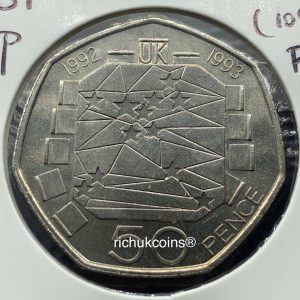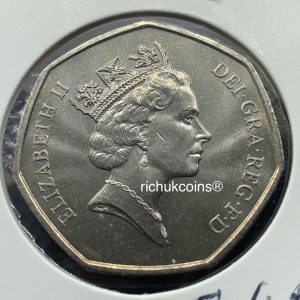Published on
Last Updated on:
It is a part that shows key designs in year order during the period of 50 years, in terms of reverse design only. It may come across portrait changes during illustration.
50 Years of the 50p coin (from 1969 to 2019)
- 50p coin: Britannia 1969 (left) vs. Britannia 2019 (right) (winner in design)
- Royal coat of arms 2013 (runner-up in design, both by Christopher Ironside)
- 50p coin, Britannia 2019 w/o privy (left) vs. 2019 w/ 2-privy










Generally speaking, product quality, in terms of coin grade, is improving from very basic to (deep) prooflike over years. Nothing is worth mentioning here really. If you have a close look at the 2019 50p coin w/o and w/ privy, there is one thing you have to address, coin w/ privy grade much better than coin w/o privy. The 2019 50p coin w/o privy was taken at the Royal Mint Experience, strike your own (syo), and originally only the place where you were able to purchase. However, the Royal Mint changed rules after the big sales of 50 years of the 50p coin proof standard and silver proof standard sets. It makes the 2019 50p syo coin a bit controversial.
Within 50 Years: “New” omitted (in 1982)
- 50p coin 1982 (left) vs. 1969 (right)




No longer “New” onwards.
Within 50 Years: 2nd Portrait to 3rd Portrait (in 1985)
- 2nd portrait [1969, 1984] vs. 3rd portrait [1985, 1997]


Within. 50 Years: GB 1st 50p circulating silver proof coin (in 1996)
- 50p Silver proof coin seated Britannia in 1996
- Provenance: the 25th Anniversary of decimalisation in 1996, UK vs. IOM






The 25th anniversary of decimalisation silver proof coin sets, both UK and IOM, were only sold to collector in silver proof finish. Note the significant difference between the UK and IOM silver proof sets above is that UK decimal silver proof and proof and BU sets were already in place in 1996. The above UK silver proof set was sold only for the purpose of celebrating the 25th anniversary of decimalisation. Also, the two 50p silver coins here were then circulating coin (i.e., a coin in daily use). In terms of integration, the IOM silver proof set had 9-coin in a set from face value of £5 down to 1p, however, the UK silver set only 7 coins were presented. With regard to popularity, the IOM 1996 silver proof set is great in demand. According to its coa, 1996 IOM silver sets were produced with a limit of 1996 sets in 1996. At this point, it is clear to say that UK numismatic products are unpopular before 2009 and most high value denominations like £1 £2 and £5 are used.
This 1996 Seated Britannia 50p silver proof coin with a limit of 15,000 coins is recognised by a few collectors in terms of coin valuation in British modern coins. The 50p silver proof coin is a real collector item, but people who collect modern coins are keen to commercial numismatic item for instance 2016 blue peter 50p silver coin. If you look at the 50p silver coin itself, it is simple and limited at 15000 coins.
Within 50 Years: A changeover from 30.00mm to 27.30mm in size (in 1997)
- 50p coin: 1997 large (left) vs. 1997 small (right)
- The existence of a choice between 7-sided 50p and circular 50p (in 1994)






Within 50 Years: Seated Britannia went down instead by Shield (in 2008)
- 50p coin 2008 Seated Britannia (left) vs. 2008 Shield (right) & 4th portrait [1998, 2015]




Importantly, all 50p coins made in 2000 onwards are at least a prooflike standard finish. This is a very significant improvement made from the Royal Mint. Seated Britannia closed her curtain on UK circulating 50p coin after 2008.
Within 50 Years: Commemorative 50p coins
During the period of 50 years, a very 1st commemorative 50p coin struck at the Royal Mint and at the Pobjoy Mint respectively, from the perspective of minter and understanding numismatic products. UK, it was 1973, which UK first joined the European Economic Community. Isle of Man, it was 1978, which was the 25th Anniversary of Coronation of the Queen E II. Two “special” 50p coins are shown at Point A and B below in depth. Point A and B are two points to support Commemorative 50p coin 1973 UK vs. IOM.
- Commemorative 50p coin 1973 UK EEC PF vs. 1978 IOM PF




It is a very interesting comparison between the two coins. Firstly, it is coin grade. 1973 EEC 50p proof coin was made with a prooflike standard finish. However, 1978 IOM Viking boat 50p proof coin was a real proof coin. At early stage of decimalisation, coins made from the Pobjoy mint were properly minted and the Royal mint were heading to political gift. Secondly, it has no competition internal and external in this market in terms of minters. Last not least, the Royal mint didnot fancy developing any 50p coin at the beginning of decimalisation, but the Pobjoy mint had different view on 50p coin.
Point A. Within the period of 50p years, contemporary GB history also created on 50p coins in 1973 and 1992/93.
- 50p coin 1973 (left) (UNC) vs. 1992/93 (right) (BUNC)
- 50p coin 1973 (left) vs. 1992/93 (right) (circulating type)




BUNC grade coin, only from year mint set.




As shown above, a BU 50p coin and a circulating type 50p coin in 1992/93 are very different in terms of coin grade. And only the circulating type was limited at 109,000 coins. This coin was seized for circulating after 1997, but it was part of decimalisation improvement. A very interesting question arises in my mind, what if the London Bridge goes down, whether is or not solid point to say that 2009 Kew Gardens 50p coin is no longer a rare circulating 50p coin? What will the entire numismatic world react on this news and changes? The system of decimal coinage will not be changed and opted out over the course of time, however, people will, its mother nature. Do people care what do they collect in value?
Point B. A 1979 Isle of Man 50p base proof coin. This is a very special coin in the range of UK 50p coins. In terms of finish, it is finalised with a proof finish, earlier than Royal Mint 1st 50p base proof coin in 1982.
- 50p 1978 Proof coin
- 50p 1978 coin (circulating coin)




50 years of the 50p coin first release (early 2019)
50 years of the 50p coin second release (mid 2019)
50 years of the 50p coin third release, possible…?
If you are keen to GB 50p coins, please go back and see 40 years of the 50p coin in 2009. But, there is nothing new and creative. It is more like a revision of 2009 job lot.
#The End